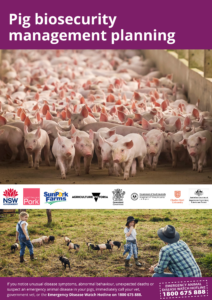Read the latest information on
Foot-and-mouth disease

On this page, you will find the tools to help you develop your own biosecurity management plan, and support the implementation of simple, everyday biosecurity practices to protect the health of your pigs. Resources are available for all levels of pig keeping and production, whether you have one or two pet pigs, a farm stay operation, hobby farm, keep pigs for your own consumption or are a small or large commercial operation and may be quality assured (APIQ accredited).
For APIQ accredited producers, refer to the APIQ site for more information on APIQ requirements and standards.
^ Biosecurity management planning templates, example file and information guide have been updated to include the mosquito management plan components.
^^ For those with an existing biosecurity management plan who now require a mosquito management plan to mitigate the risk of Japanese encephalitis to their pigs
* Includes link to the APIQ standards for those who are APIQ accredited.
** Pig biosecurity management plan: Information guide may be used to assist completion of the checklist and plan template.
The single biggest threat to the pork industry’s sustainability is an outbreak of an emergency animal disease:
All pig owners and producers need to remain vigilant and report any unusual signs of disease or death to their veterinarian or government agency via the national Emergency Animal Disease Hotline on 1800 675 888.
An outbreak of FMD could cost up to $80 billion over 10 years. ASF could cost up to $2billion over many years to control and will impact pet, hobby and commercial operations alike. Japanese encephalitis has had significant financial and production impacts at the farm and industry level.
The pig biosecurity management planning toolkit has been developed to support pig owners and producers to safeguard their pigs against the biosecurity threats posed by unwanted pests and diseases.
The Biosecurity management planning toolkit and the mosquito management planning toolkit was developed as part of a NSW Department of Primary Industries led initiative, partnering with:
